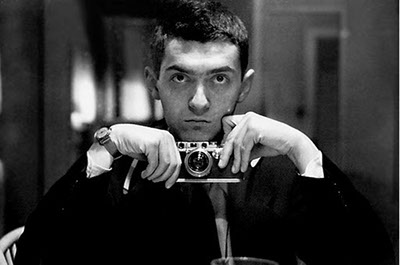Kubrick photographer
by Paolo Valassi
www.orizzontikubrickiani.it
On his thirteenth birthday, Stanley Kubrick received his first camera, a 33 mm Graflex, as a gift from his father.
We can safely say that this event was the most important turning point in his life: although very young, he became an expert photographer and explored all of New York in search of images, already demonstrating a frantic search for the right shot, a maniacal attention to the staging and an innate talent for “fixing” the world through photography.
A talent that he would transfer years later into his films, which, in fact, could be read as a succession of individual shots.
One of these photos was noticed: it was the image of a newspaper vendor saddened by the death of F. D. Roosevelt; Look magazine bought it for 25 dollars.
It is well known that Kubrick managed to convince the newsagent to assume a distraught expression. But it doesn't matter: here his manipulative ability aimed at telling a story is already clear.
At seventeen he was hired on the staff of Look as an apprentice photographer.

Kubrick recalled that period:
"There is a well-known aphorism that when a director dies he becomes a photographer. It is a keen but somewhat superficial observation, and usually comes from the kind of critics who complain that a film has too good photography. In any case, I started out as a photographer. I worked for Look magazine from the age of seventeen to twenty-one. [...] The experience was invaluable to me, not only because I learned a lot about photography, but also because it gave me a quick education in the way things were done in the world. [...] I had a tremendous time at that age, but eventually the clothes became too tight for me, especially as my greatest ambition had always been to make films. The subjects Look gave me were usually quite stupid. [...] Occasionally I had an opportunity to do an interesting story about some character. One of them was about Montgomery Clift, who was at the beginning of his brilliant career. Photography certainly gave me the first step towards films. To shoot a film entirely by yourself, as I did initially, you may not know much about anything else, but you have to know photography well."
But what is Kubrick's stylistic signature as a photographer? Let's let Kubrick speak again:
"It has always seemed to me that true and truly artistic ambiguity [...] is the most perfect form of expression, for several reasons. First, no one likes to be told something. Second, no one likes to be told the truth about what is happening. And perhaps more importantly, no one knows what is true or what is happening. I believe that truly perfect ambiguity is something that has several meanings, each of which could be true and which simultaneously push the spectators, from an emotional point of view, in the direction you want them to move. On the other hand, I think that every literal, flat and clear statement is, in its turn, false and will never have the power that perfect ambiguity has."
In this sentence, taken from an interview given in 1960 to the English newspaper The Guardian, there is all of Kubrick's cinema.
